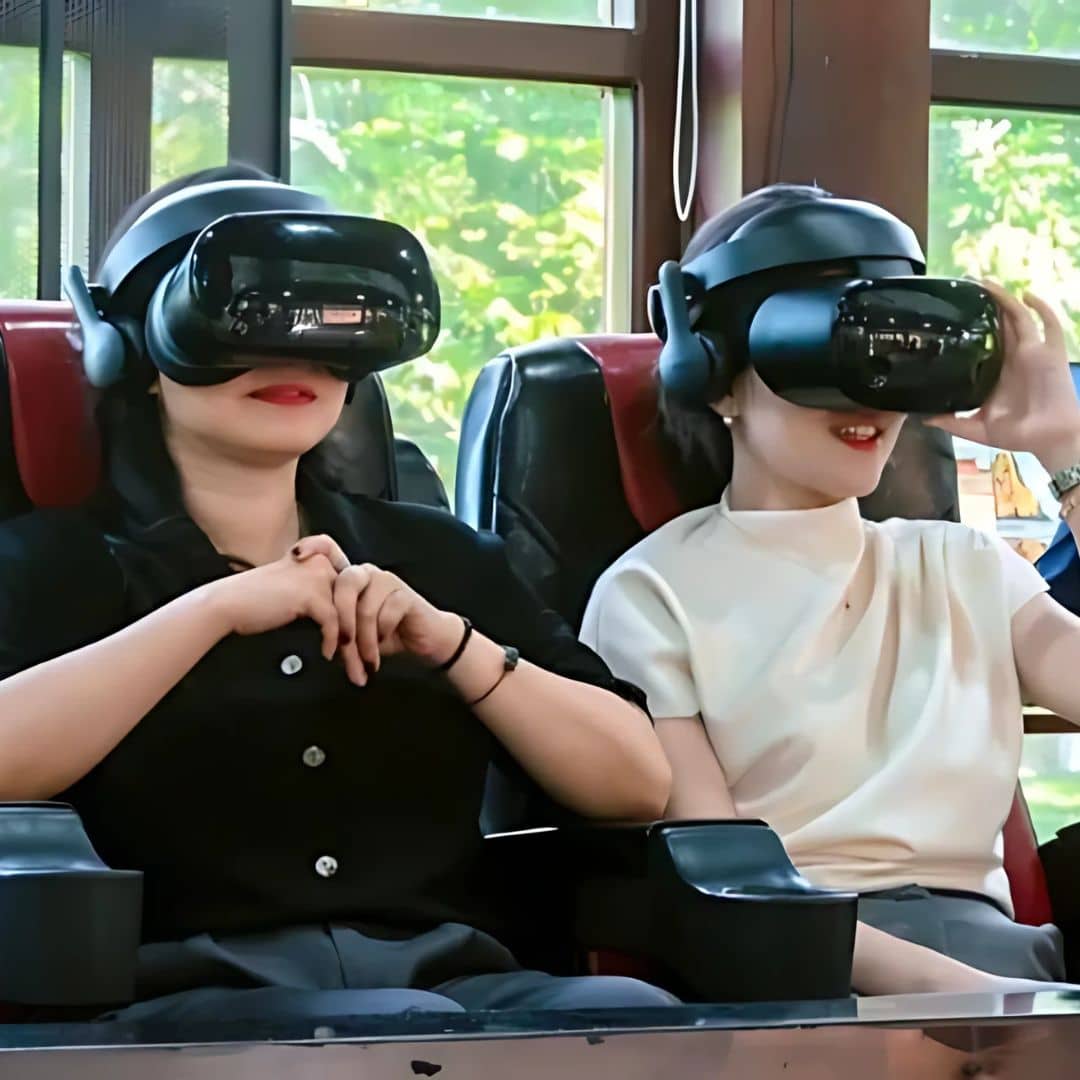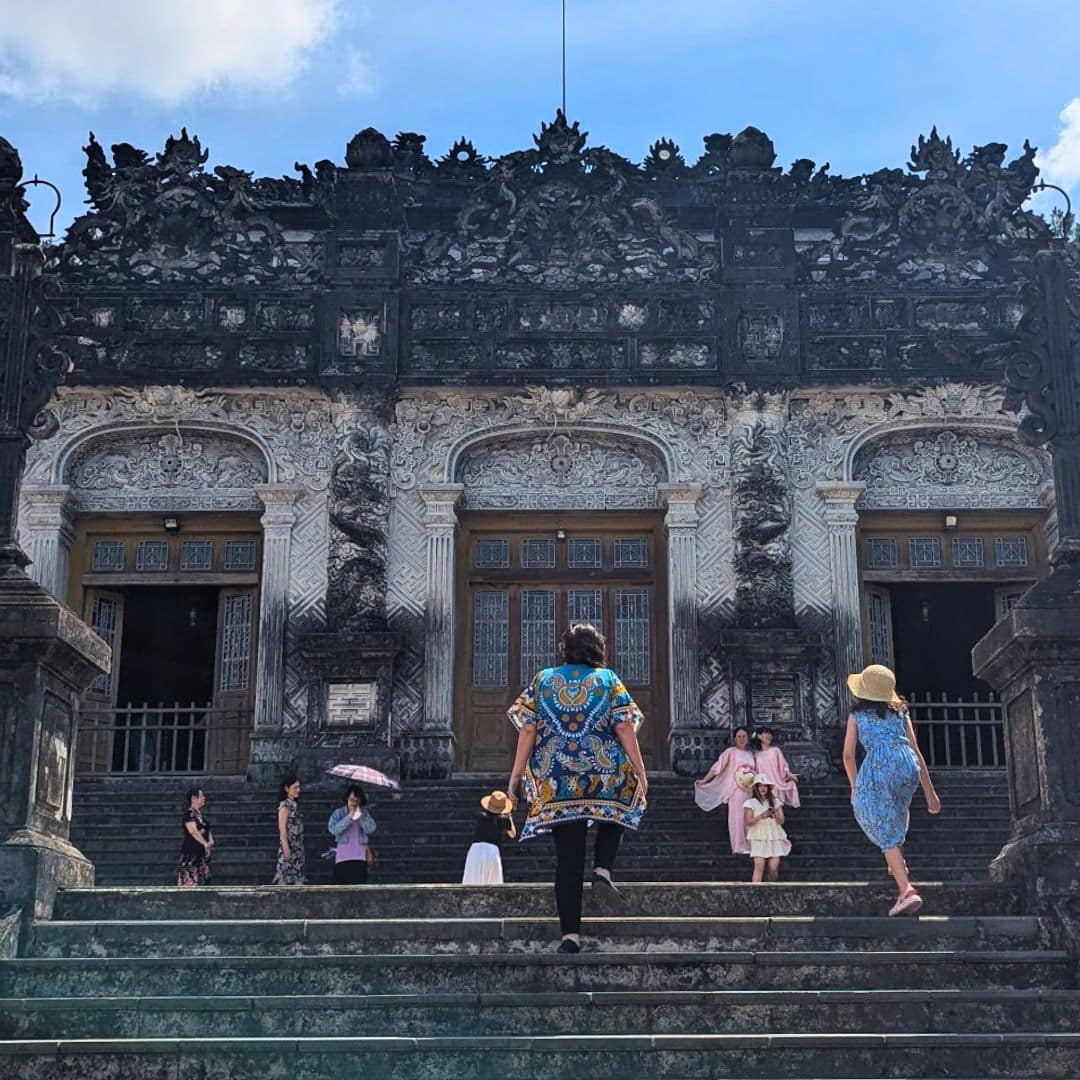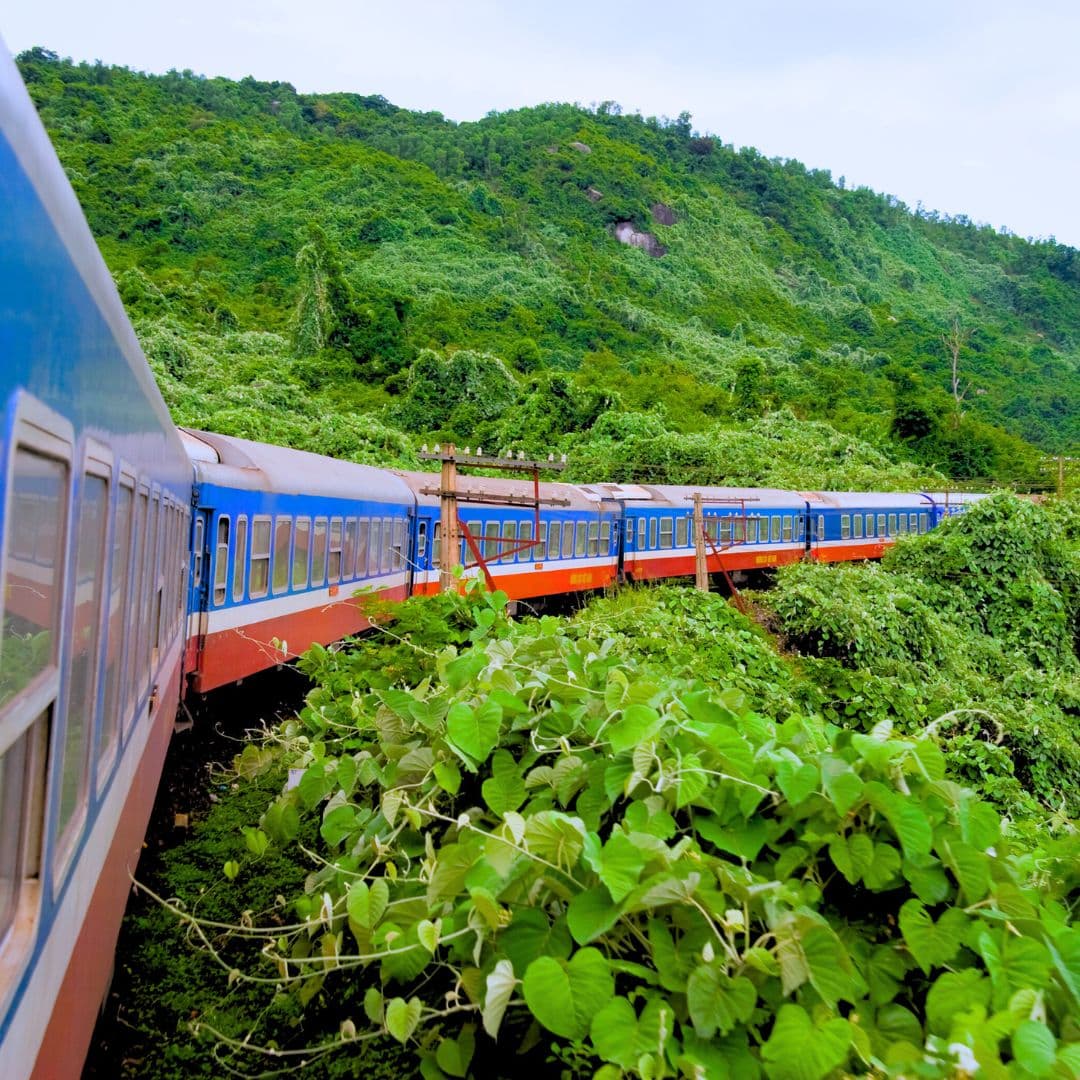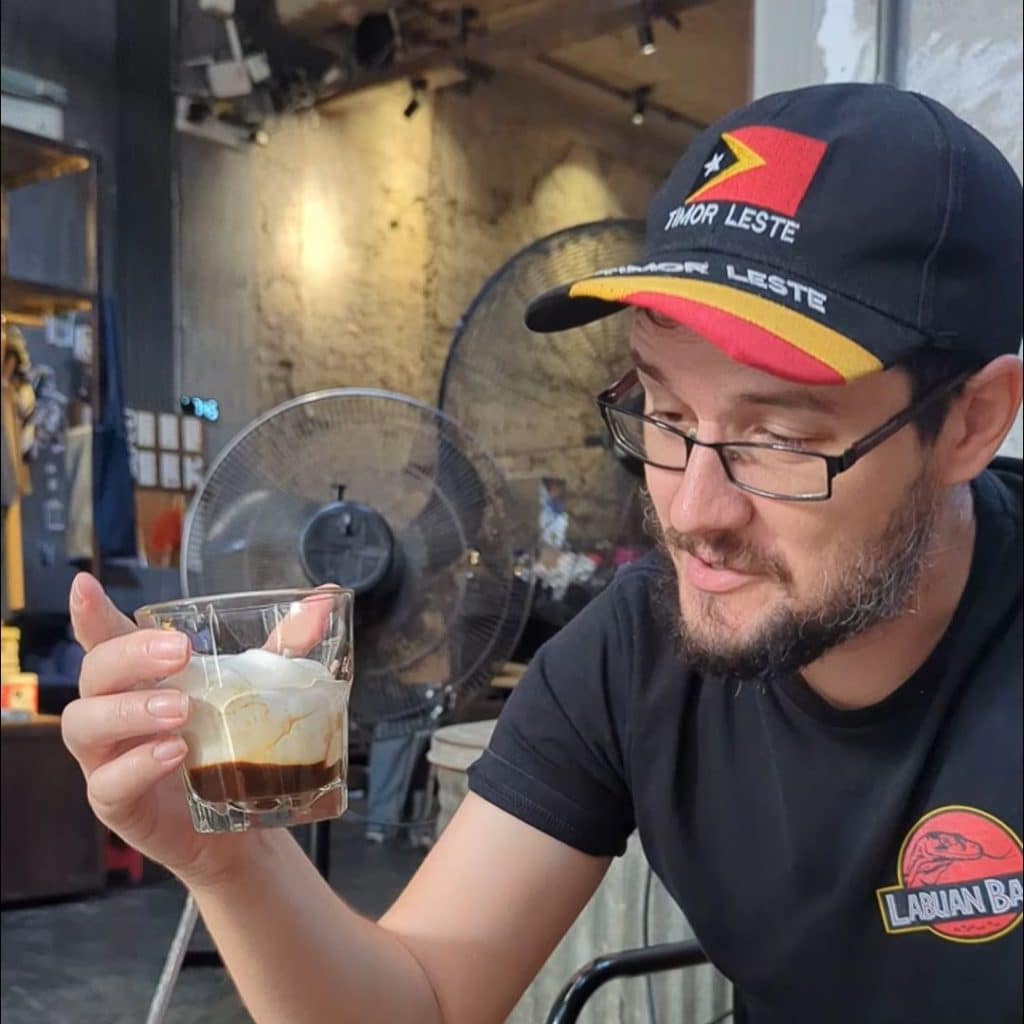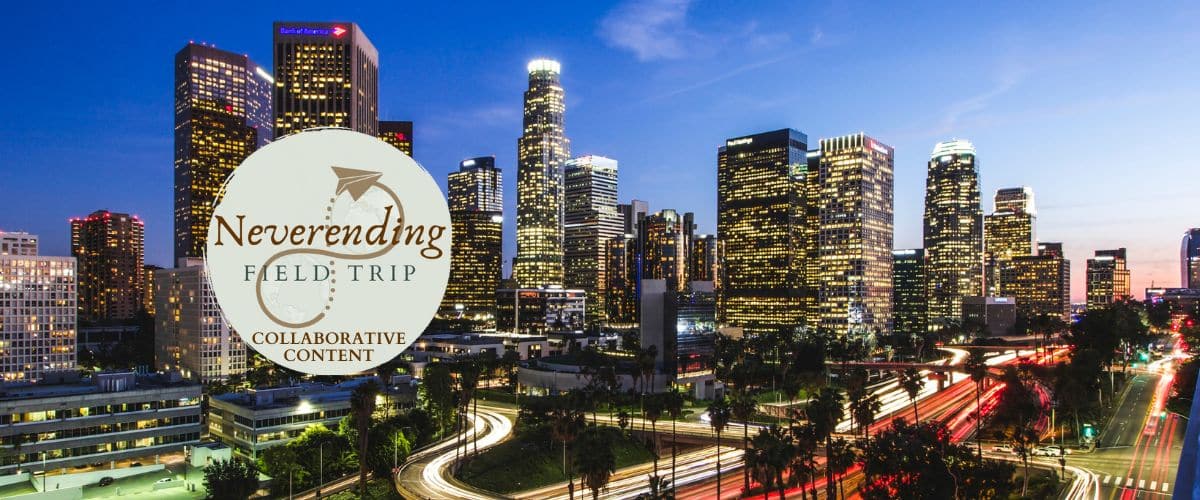Stepping into Vietnam’s Past in the Imperial City of Hue
Located just a few hours north of Da Nang in Central Viet Nam, the Imperial City of Hue was once the capital of the entire country and the home of the Vietnam’s kings. Today, it remains an incredible location for families looking for adventure with a healthy serving of history (and coffee) on the side.

Hue’s Ancient Imperial City
Hue was originally a a part of the Champa Kingdom, long before Vietnam was ever a unified country, but rose to importance as a “feudal capital” of the Inner Realm starting in the year 1687. It changed hands several times over the subsequent years, though it remained an important city in each case, until it became the capital of a unified Vietnam under the Nguyen Dynasty kings.
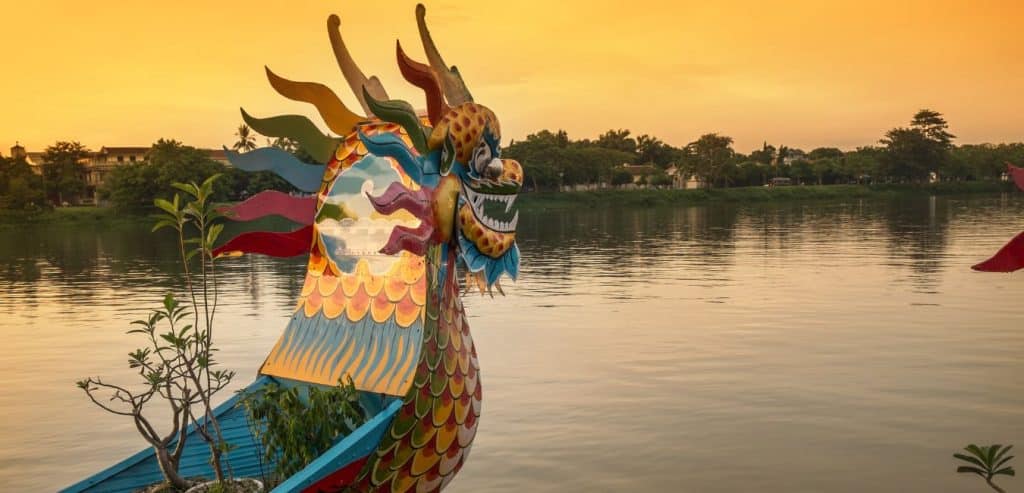
During the beginning of this dynasty, Vietnam was an independent country with borders similar to what are seen today, however in the mid-1800s, France took an interest in colonizing the Indochina region and began colonizing Vietnam, along with Cambodia and Laos. Eventually France took power over the whole region. During this time, Hue remained the imperial capital of Vietnam under the Nguyen Dynasty, though each successive king held less real power until Japan took over Vietnam in the 1940s as part of their WW2 offensive.
Following the end of WW2, the French tried to re-establish their presence in Vietnam, but a local group called the Viet Minh resisted. Ultimately, the country became divided into north and south in 1954. Hanoi became the capital in the North and Saigon the capital in the south. The next year, 1955, was the official beginning of the American-Vietnam War, as America tried to use its military to force French rule on the Vietnamese people.
Unfortunately, during the course of this war, much of Hue’s Imperial City was heavily damaged. Of the estimated 160 buildings that stood in the Imperial City, an estimated 148 were destroyed. Today, only 10-20 of the original buildings still stand, depending on who you ask.
Following the war, restoration work in the city began, and in 1996 Hue was named a UNESCO Cultural Heritage Site. Even so, the restoration has only just begun and there is still much work to do!
What part of Hue is the “Imperial City”?
If you plan on visiting Hue, it’s worth noting that the Imperial City of Hue is only a small part of modern Hue, locate just north of the Perfume River. Several man-made canals and tall stone walls line the outer edges of the Imperial City, giving it a nearly square shape which aided in the city’s defensibility.
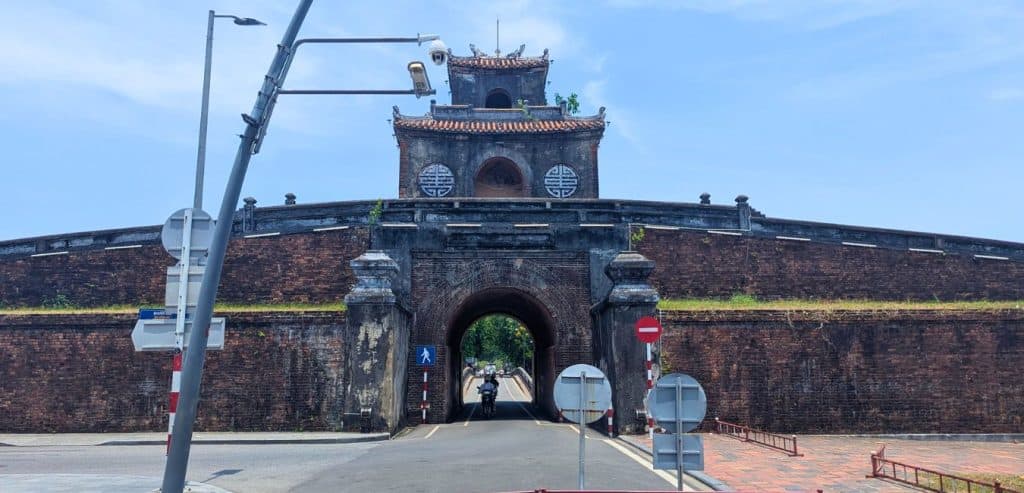
Those canals give the area a visible outline that can be easily seen on maps. Today, the entire space within those walls, except for the Citadel, is filled with shops, museums, hotels, and restaurants, making the Imperial City one of the best places to stay in Hue for those wanting to explore as much as they can on foot!
There is no cost to enter the Imperial City section of Hue.
Points of interest in the Imperial City (Outside the Citadel)
The Imperial Citadel is definitely the main attraction in the Imperial City. However, since you have to pay entrance to get inside, and because there’s much in the way of food or shopping inside, you’ll definitely also be spending at least some time in the area outside the Citadel.
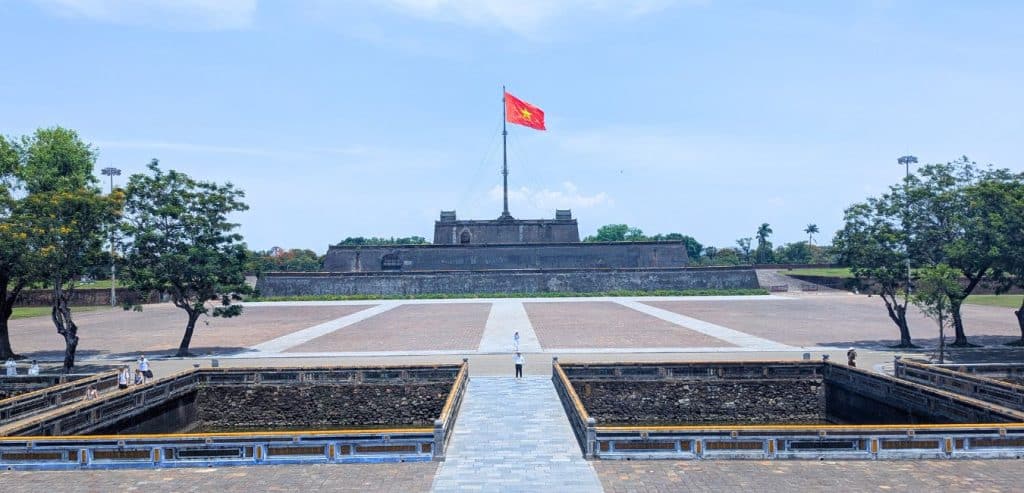
Here are some of the best spots to visit outside the Imperial Citadel:
- Hue Royal Antiquities Museum – One of the best museums in Hue for admiring royal relics from the Nguyen Dynasty. Not a lot of information on the signage, though.
- Dong Ba Market – The oldest operating market in Hue. A great place to pick up souvenirs or just grab something to eat!
- The National Library of the Nguyen Dynasty – This small building located north of the Citadel is where the Nguyen kings kept their records. It is said the building is surrounded by water as a way to discourage fires from spreading.
- The Kỳ Đài Flag Pole – This is a three-tier pyramidal flagpole located outside the Citadel’s Sun Gate bordering the parade grounds. While it’s pretty cool to see a huge flag like this, it’s extra useful as an orienting landmark since you can see it from so far away.
- Thanh Toan Bridge – Thanh Toan is a tile-roofed bridge over one of the canals in the Imperial City. It’s a great place to sit in the shade and watch the river for a few minutes!
What part of Hue is the “Imperial Citadel”?
Of course, while there are plenty of things to see and do in the larger Imperial City, the real highlight of Hue is the Imperial Citadel!
Hue Imperial Citadel
Cost of Entry: 200k/Adults or 40k/kids 7-12
Hours: 7:00am-5:30pm, daily
You can either buy your tickets at the booth near the entry gate (cash only) or, for about $0.25 more per person, you can buy them online with Klook before you arrive to skip the line!
A walled-off section of buildings within the larger walls of Hue, the Citadel was once the home of Vietnam’s kings under the Nguyen Dynasty. It was loosely modeled on Beijing’s Forbidden City and constructed according to the principles of feng shui, though, sadly, as with the Imperial City outside the walls, much of what once stood within the Citadel was destroyed during the war.
Despite the extensive damage, the Citadel’s interior is still seriously impressive. My family spent nearly 5 hours wandering the different palaces, museum displays, and gardens, and we still didn’t see everything there!
Traveler’s Tip: There are only a couple places inside the Citadel where you can buy drinks or snacks. Be sure to bring plenty of water with you, especially on hot days!
Obviously, you don’t have to spend all day there, but if you want to make sure you get the most out of you entry tickets, there’s definitely a lot there to check out!
The Meridian Gate
This is the main gate that you pass through to get into the citadel. But quite apart from simply being an entryway, it’s worth checking out the upper sections of the gate as well! Not only are there several different museum displays in the upper levels (including a 3D model of the entire Citadel), but the view from on top is beautiful!
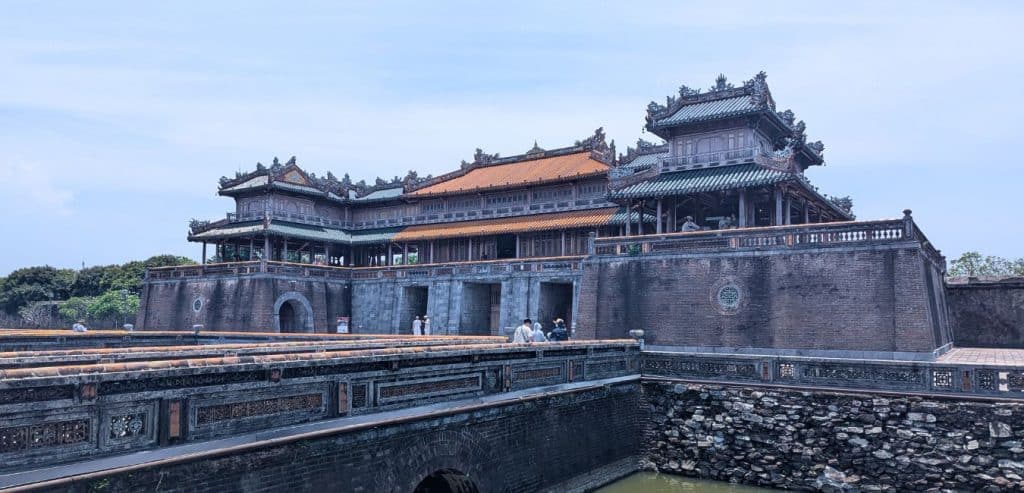
Thái Hòa Palace
Thai Hoa Palace is one of the first structures that you will see upon entering the Imperial Citadel, and it makes a great first impression!
This was the place where the coronation ceremonies for the kings took place, and it retains that regal air. The interior is filled with red and gold lacquered columns and the Golden Throne, which was a symbol of the king’s power.
Trường Lang
Located to the rear of the Thai Hoa Palace, the Trường Lang is essentially a long, covered, open-air corridor that was used to connect together the different palaces of the Citadel. This particular corridor also features several small rooms with dedicated exhibits explaining the site’s history and, in some spots, bullet holes left over from the war.
Kiến Trung Palace
Located on the far side of the Imperial Citadel from the Meridian Gate sits the Kiến Trung Palace. This palace served as the residence for Vietnam’s final two kings, Khai Dinh and Bao Dai. However, the palace was destroyed completely in 1947 during the first Indochina War.
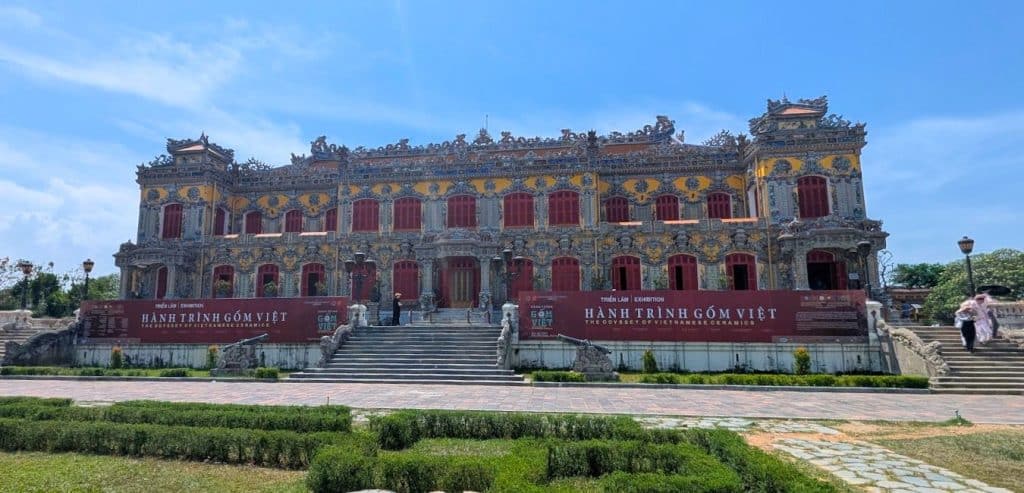
Restoration on the palace was started in 2019, and it was officially re-opened to the public in 2024 once the restoration was complete. Today, it acts as a museum of sorts, with artifacts belonging to the kings who called it home on display.
Thiệu Phương Garden
This beautiful garden ended up being on of my favorite spots in the entire citadel! Featuring 4 interconnected pavilions with hallways forming a Buddhist Vạn symbol, these beautiful gardens feature a variety of flowers, water features, and stone gardens.
I love the entire feel of the space, and the shady walkways were very welcome since it was pretty hot on the day we visited.
As a bonus, just outside the eastern gate to the garden is the Cơ Hạ gardens, which, while also beautiful, stole our kids hearts for being the spot where we found a small cafe serving french fries!
Duyet Thi Duong Royal Theater
Unfortunately, we didn’t time our trip right to be able to see one of the twice-daily performances at the Royal Theater. (I failed to do my research!) But everything I’ve seen about them points to them being one of the best experiences in the Citadel and absolutely worth going out of your way to see!
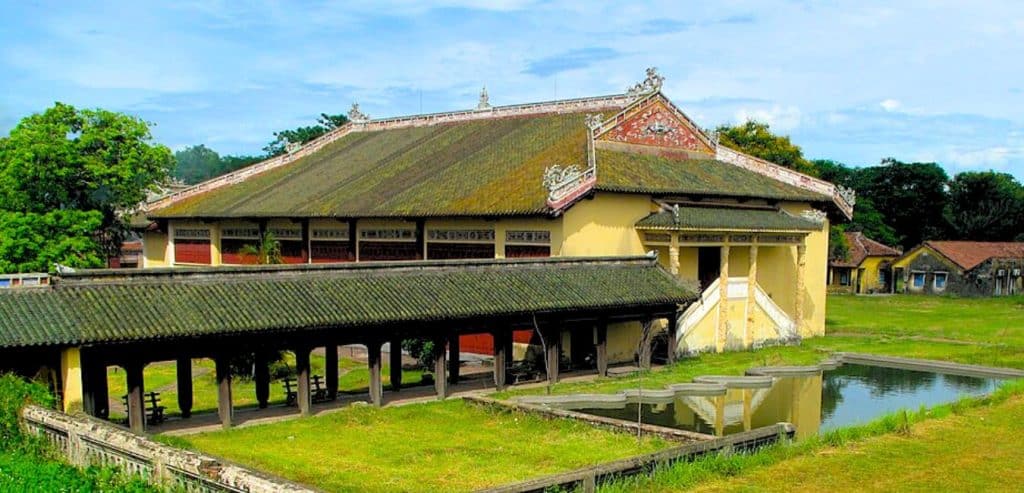
The theater itself has a variety of exhibits on display, including musical instruments, masks, and costumes that would have featured in the theater during the time of the kings, but the real draw for most visitors are the music and dance shows that happen here.
The shows do cost a bit extra on top oḟ the entrance tickets, (200k/person), but the shows are worth it! You can buy the tickets in-person right at the theater.
Showtimes
|
Morning Show |
10:00am-10:35am |
|
Afternoon Show |
3:00pm-3:35pm |
Other points of interest
These were the main areas that we visited during our hours of exploration, but they definitely aren’t the only points of interest in the Citadel. In fact, many tours suggest walking along the western edge of the Citadel and exploring the Temples there, but because of the route we chose and the heat of the day, that proved to be too difficult for us to visit on top of what we had already done.
I’ve included a map of the Citadel with all the points of interest I’ve heard recommended listed, though it’s definitely worth doing some exploring on your own to see what else you can find!
Bonus Item 1 – VR/XR Center
There are a couple other activities at the Citadel that we saw during our visit that I haven’t seen mentioned on other blogs, but which could be a lot of fun for families.
The first was the new VR Center located behind the Thái Hòa Palace. They have VR/XR systems that you can rent with immersive experiences programmed in so you can get a better picture of what life in Hue’s Imperial Citadel was like before it was destroyed in the fighting.
It looked super cool for what it was and definitely caught my kids’ attention, but ultimately we passed on it in favor of exploring on our own. But I’d definitely be interested in hearing what it was like, if you choose to give it a go!
This VR experience takes visitors on a virtual tour of the Imperial Citadel with full, VR reconstructions of the different sites as they would have been in their glory days.
It's also worth noting that this is one of only a handful of air-conditioned spots in the Imperial Citadel, making it a fun rest stop in the middle of your day!
Bonus Item 2 – Traditional Arts and Crafts
I haven’t seen this mentioned on anyone else’s page, but near the eastern gate of the Citadel, we stumbled upon a building called the “Immersive Art and Creativity Space” where we were able to sign my daughter up for several traditional art classes, including print-making and tile mosaics!
Despite not being listed anywhere online, as far as I can tell, this ended up being my daughter’s favorite spot of the day, and she spent several hours doing art with the ladies who work there.
Payment was cash only, so be sure to bring some extra along with you, but it’s definitely worth it! Different classes cost different amounts, and, unfortunately, I didn’t take note of all the different options, but I think we paid something like 500k VND for my daughter’s experience.
Tombs of the Kings
While Hue’s Imperial City is where Vietnam’s kings spent their lives, you can also get a glimpse into the architecture and history of that time period by visiting the different tombs of the kings in the surrounding countryside!
One
This tour on Get Your Guide not only visits the three most popular of the emperors' tombs in the area, but also spends time at the Thien Mu Pagoda, the local incense village, and adds on a trip down the Perfume River on a dragon boat, to boot!
I prefer booking my tours via Get Your Guide as they often feature smaller (read: more local) agencies with guides who really know the area. And when you consider that GYG often has less expensive options when compared with larger sites like Viator, it's a clear winner!
I really enjoyed our visits to the tombs, as it helped me to focus in on the individual kings and learn more details about their lives and roles as rulers in Vietnam!
Tomb of Minh Mang
Emperor Minh Mang was one of the earlier Emperors of the Nguyen Dynasty that made Hue their capital. Ruling from 1820-1841, Minh Mang was responsible for a variety of public works that aided Vietnam’s development during that time period.
Minh Mang’s Mausoluem is one of the larger tombs in the area, and the grounds include two large ponds are decorated with blooming lotus flowers, a small pine forest, and beautiful buildings constructed in a classical Vietnamese style.
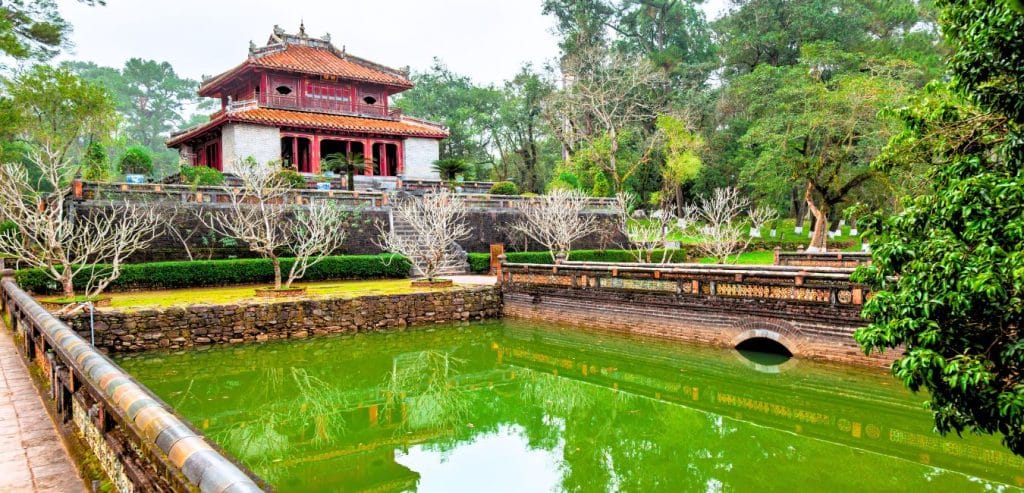
Tomb of Tu Duc
Reigning from 1848-1883, Emperor Tu Duc was the longest reigning emperor of the Nguyen line. However, it was during his reign that France began its colonization efforts in the region with the capture of Da Nang in 1858. Thus Tu Duc witnessed a waning of his Kingdom’s power from that point until his death in 1883, just 4 years before France’s establishment of French Indochina, which encompassed Vietnam, Laos, and Cambodia.
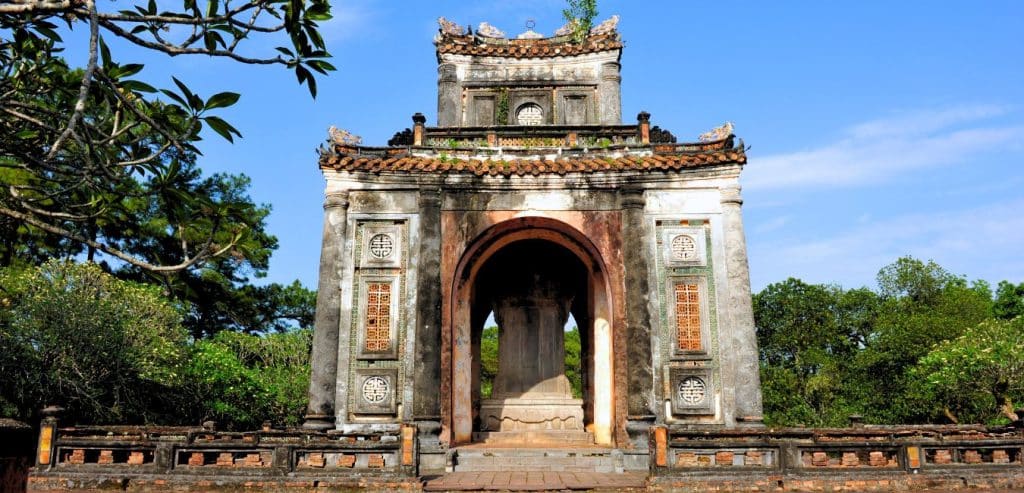
Perhaps unsurprisingly, seeing the waning of the Nguyen Dynasty’s power, coupled with his own inability to father a child, led to Emperor Tu Duc focusing much of his later life on the construction of his own tomb. He completed its construction in 1867 and was known to frequently visit it as a retreat.
Tu Duc’s tomb is known as one of the more beautiful of the the Nguyen Emperors’ tombs, and is often very busy, so it’s worth visiting earlier in the morning or later in the afternoon when the crowds are less.
Tomb of Khai Dinh
Khai Dinh (Khải Định) was the 12th Nguyen Emperor of Vietnam and reigned from 1916 until his death in 1925. Unlike his predecessors, Emperor Khai Dinh worked closely with the French occupiers in the region and was chosen by the French government to serve as a figurehead monarch of the colonial government.
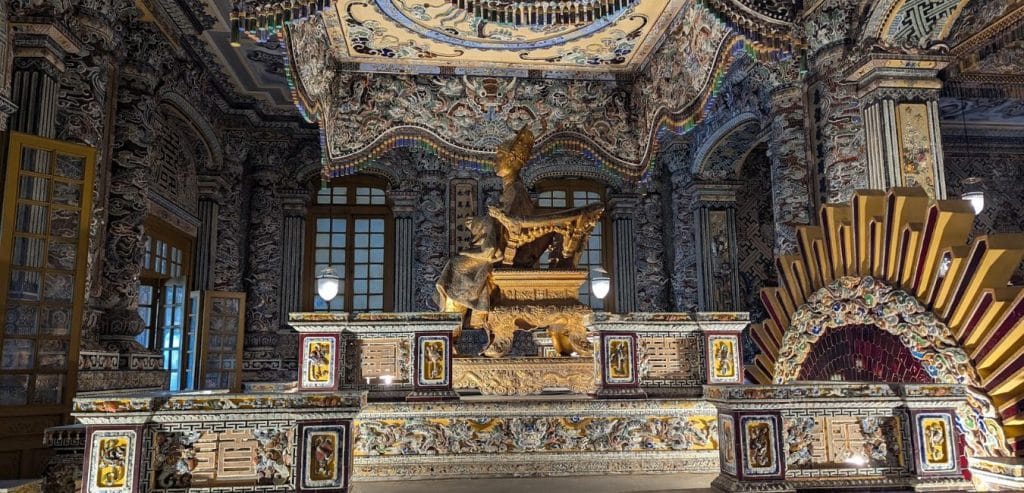
Needless to say, this made him extremely unpopular with the Vietnamese people, and he only became more unpopular as his reign continued. In 1923, 2 years before his death, Khai Dinh began raising taxes on the local peasantry for the express purpose of raising funds for the construction of his tomb, further cementing his place as one of the most unpopular emperors in this dynasty.
Over time, he became addicted to drugs and, in 1925, he succumbed to tuberculosis and died, ending his reign. While the title of emperor was passed on to his son, Bảo Đại, Khai Dinh was the final emperor to have a tomb constructed for him in the Hue region.
Despite Khai Dinh’s unfortunate history, the tomb itself is impressive. The exterior structure is made primarily of dark gray concrete, but reflects the ancient building styles of Vietnam. However, the interior portion of the tomb features intricate porcelain work, and feels almost like a French palace.
Other Nguyen Tombs
While these are the three most popular tombs in the Hue Region, several of the other emperors also constructed elaborate tombs that you can visit, while others were buried in smaller tombs in the An Lăng Cemetery (which I did not have a chance to visit!). However, most of the tours in the area stick to the three main tombs listed above, so if you are interested in seeing them all, you will either need to visit on your own or choose a tour provider in Hue that allows you to create your own itinerary.
For easier reference, I’ve listed out the locations of all the tombs of the Emperors below.
A More Recent History – Visiting Hue’s Dragon in the Waterpark Ruins
While Hue’s importance to the Vietnamese people faded following the division of Vietnam into North and South and the subsequent moving of the Capital, the city has found a more recent rise to prominence in a much more modern venue: Instagram.
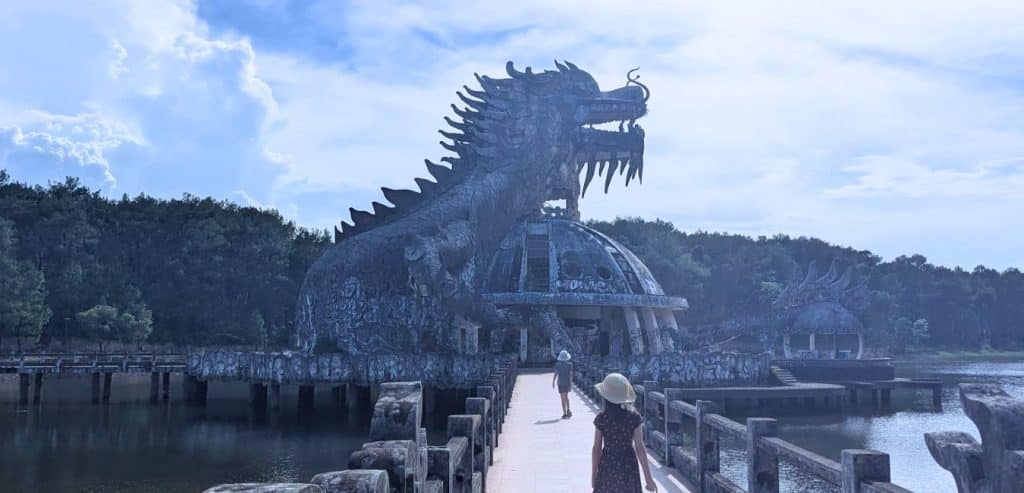
Located just outside of Hue, near to the tomb of Khai Dinh, lie the remains of an ambitious waterpark project called Hồ Thuỷ Tiên. Costing just over $3 million USD to build, the park quickly fell into debt and was forced to close in 2006. However, while the park fell into disrepair and ruin, one of the buildings found there gained internet fame due to a dragon sculpture wrapped around its central dome.
The urban ruins of the dragon building caught the eye of Instagram-ers looking for the next new spot, and quickly went viral! For a long while, local-level government in the area discussed what they should do with the dragon, and they almost decided to tear it down, but in 2025 it was decided that they would instead transform the park into a community greenspace and keep the dragon.
A large part of the allure of the dragon building up to this point has been the idea of exploring “urban ruins,” so I’m not sure how plans to renovate and repair the building will affect things moving forward, but having visited the spot myself, I definitely think turning the area into a community park is a great choice!
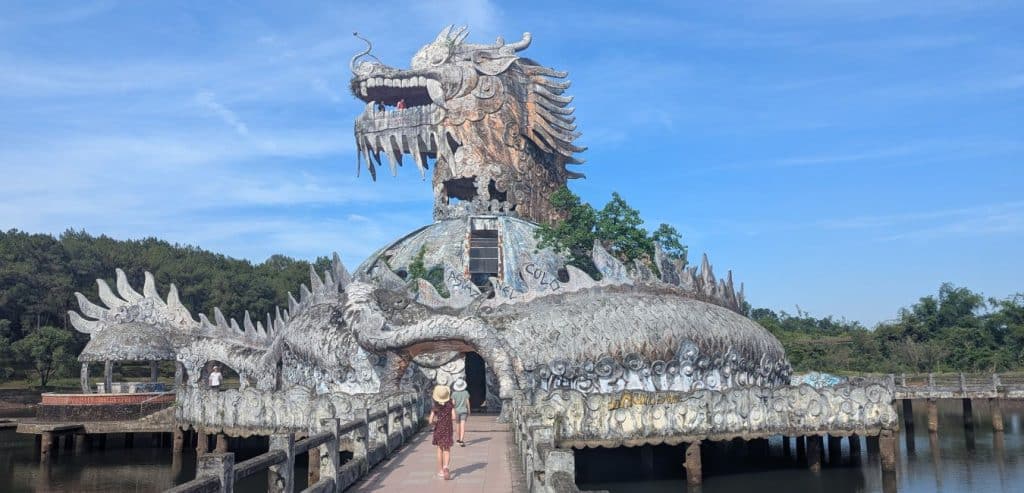
How can you visit Hue’s Dragon?
The dragon building was built on the far end of Thuy Tien lake to the southwest of Hue, and it’s super easy to get there!
All you need to do is hire a Grab or a local taxi and let them know that you want to visit the abandoned waterpark. They’ll definitely know what you’re talking about and drive you straight there.
I’ve heard that there’s no entry fee required to get in, but there will almost certainly be people there who ask for payment at the entrance. They asked us for 25k (about a dollar) each to enter, and we found it easier to just pay.
There’s a walking path that goes around the entire outline of the lake, and we saw tons of locals taking walks or going for an evening run while we were there. The dragon building itself was a bit trashed, with lots of graffiti and stickers covering basically every wall. Cracked glass lined nooks where aquariums once stood, and basically every wall had decorations of some sort.
Stairs on the inside lead all the way up to the mouth of the dragon, where you can look out over the lake.
Overall, it was a really cool experience!
FAQs
Interested in visiting Hue with your family? Here are some quick and practical answers to some common questions!


